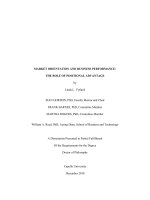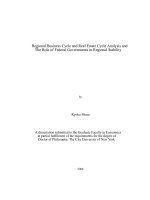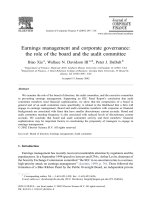Market orientation and business performance The role of positional advantage
Bạn đang xem bản rút gọn của tài liệu. Xem và tải ngay bản đầy đủ của tài liệu tại đây (1.24 MB, 134 trang )
MARKET ORIENTATION AND BUSINESS PERFORMANCE:
THE ROLE OF POSITIONAL ADVANTAGE
by
Linda L. Vytlacil
JEAN GORDON, PhD, Faculty Mentor and Chair
FRANK BARNES, PhD, Committee Member
MARTHA ROGERS, PhD, Committee Member
William A. Reed, PhD, Acting Dean, School of Business and Technology
A Dissertation Presented in Partial Fulfillment
Of the Requirements for the Degree
Doctor of Philosophy
Capella University
December 2010
UMI Number:
3439658
All rights reserved
INFORMATION T
O ALL USERS
The quality of this reproduction is dependent upon the quality of the copy submitted.
In the unlikely event that the author did not send a complete manuscript
and there are missing pages, these will be noted. Also, if material had to be removed,
a note will indicate the deletion.
UMI
3439658
Copyright 2
011 by ProQuest LLC.
All rights reserved. This edition of the work is protected against
unauthorized copying under Title 17, United States Code.
ProQuest LLC
789 East Eisenhower Parkway
P.O. Box 1346
Ann Arbor, MI 48106-1346
C:\Users\Linda\Documents\My Documents\Capella\OM9996 Dissertation I\VYTLACIL DISSERTATION FINAL DRAFT2 with
edits saved to pdf.docx
©
Linda Vytlacil, 2010
C:\Users\Linda\Documents\My Documents\Capella\OM9996 Dissertation I\VYTLACIL DISSERTATION FINAL DRAFT2 with
edits saved to pdf.docx
Abstract
U
nderstanding business performance is the cornerstone of research in strategic
management, and explaining how strategy influences performance is the fundamental
object of inquiry for the discipline. Yet little in the strategic management literature
recognizes the influence of marketing on business performance. Connecting marketing
management and strategic management literatures is not trivial and involves more than
just a translation of language, but rather a true bridging of the relevant literature in a
cross-discipline spirit. While perhaps reasonable to implore strategic management
researchers to adopt marketing concepts, this cross-discipline spirit can be advanced by
the adoption of strategic management empirics into marketing’s models. Marketing
researchers have commenced building this bridge by investigating the relationship
between business strategy and market orientation in the overall context of business
performance, and this study contributes to that body of knowledge by investigating
simultaneously the relationship among the key constructs of market orientation (customer
orientation, competitor orientation, and interfunctional coordination), positional
advantage (differentiation advantage and cost advantage), and business performance
(market performance and financial performance). Using a single-informant approach, 144
executives from among U.S. manufacturers responded to an email invitation to
participate in a web-based survey, and models tested from the collected data were
covariance structure models with multiple indicators for all latent constructs. Results
reveal that customer orientation has a positive effect on differentiation advantage, while
interfunctional coordination has a positive effect on low cost advantage. One interesting
C:\Users\Linda\Documents\My Documents\Capella\OM9996 Dissertation I\VYTLACIL DISSERTATION FINAL DRAFT2 with
edits saved to pdf.docx
finding is that competitor orientation has no effect on
either component of positional
advantage. The findings also show that both differentiation advantage and cost advantage
have a positive effect on market performance. We also find that market performance is a
distinct construct from financial performance in the operationalization of business
performance, and the results indicate an indirect path from positional advantage to
financial performance through market performance. Finally, results indicate that the
market characteristics of market turbulence and technological turbulence have no
moderating effect between the market orientation components and positional advantage,
nor do they indicate that the choice of an analyzer or prospector strategy type moderates
the relationship between the market orientation components and positional advantage.
iv
Dedication
F
or Tom.
v
Acknowledgments
T
he author acknowledges her husband, Tom, who continues to be the best and
most positive influence imaginable to me as a wife, mother, and professional. You are my
greatest cheerleader, and I admire you. The author also acknowledges her children, Max
and Emma, who are indeed “the best kids on the planet.” The author also wishes to
acknowledge her father, Guenter Schmidt, who instilled courage, resilience, and a
passion for learning.
The author wishes to acknowledge her mentor, Dr. Jean Gordon, and Dr. Frank
Barnes, whose encouragement has been essential to help me complete one of my life’s
goals. The author acknowledges Dr. Martha Rogers, who inspired my passion for “the
customer” and the value of demand-side thinking.
vi
Table of Contents
A
cknowledgments v
List of Tables ix
List of Figures xi
CHAPTER 1. INTRODUCTION
Introduction to the Problem 1
Background of the Study 4
Statement of the Problem 6
Purpose of the Study 7
Rationale for the Study 8
Research Questions 8
Hypotheses 9
Significance of the Study 10
Definition of Terms 11
Assumptions and Limitations 13
Conceptual Framework 14
Organization of the Remainder of the Study 15
CHAPTER 2. LITERATURE REVIEW
Market Orientation 16
Measures of Business Performance 33
Positional Advantage and Market Orientation 42
CHAPTER 3. METHODOLOGY
Introduction 45
vii
Research Questions 46
R
esearch Variables 47
Hypotheses 48
Research Design 56
Sample 56
Measures and Instrumentation 57
Data Collection 58
Data Analysis Plan 60
Reliability and Validity 62
Ethical Considerations 64
CHAPTER 4. DATA ANALYSIS
Introduction 65
Data Collection Plan 65
Pilot Study Results 66
Field Study Results 67
Exploratory Factor Analysis of the Path Model 69
Confirmatory Factor Analysis of the Proposed Measurement Model 72
Confirmatory Factor Analysis of the Modified Measurement Model 76
Assessment of Reliability and Validity 80
Causal Path Model Testing of the Proposed Structural Model
and Hypothesis Testing 82
The Moderating Effects of Market Environment and Strategy Type 88
Modification to the Structural Model 90
viii
CHAPTER 5. RESULTS, CONCLUSIONS, AND RECOMMENDATIONS
Introduction 98
Results and Implication 98
Study Limitations 101
Recommendations for Further Research 102
REFERENCES 104
APPENDIX A. SURVEY INSTRUMENT 117
APPENDIX B. EXPLORATORY FACTOR ANALYSIS 121
ix
List of Tables
T
able 1. Number of Employees 68
Table 2. Job Title 68
Table 3. Number of Respondents by Firm Size 69
Table 4. Means, Standard Deviations, Reliability Coefficients, and Inter-Construct
Correlations 71
Table 5. Goodness of Fit Indexes for the Initial Measurement Model 74
Table 6. Maximum Likelihood Estimates for the Indicator Variables of the Initial
Measurement Model 75
Table 7. Correlations Between Constructs for the Initial Measurement Model 76
Table 8. Factors Removed for the Proposed Modified Measurement Model 77
Table 9. Goodness of Fit Indexes for the Modified Measurement Model 77
Table 10. Maximum Likelihood Estimates for the Indicator Variables of the
Modified Measurement Model 79
Table 11. Correlations Between Constructs for the Modified Measurement Model 80
Table 12. Indicator and Composite Reliabilities 81
Table 13. Goodness of Fit Indexes for the Structural Model 84
Table 14. Maximum Likelihood Estimates for the Indicator Variables of the
Theoretical Model 85
Table 15. Results of the Path Analyses 87
Table 16. Group Sizes for Market Characteristics 89
Table 17. Response Frequency for Strategy Type 89
Table 18. Tests for the Moderating Effects of Market Characteristics and
Strategy Type 90
Table 19. Goodness of Fit Indexes for the Modified Structural Model 94
x
Table 20. Maximum Likelihood Estimates for the Indicator Va
riables of
the Modified Structural Model 96
Table 21. Results of the Path Analyses for the Modified Structural Model 97
xi
List of Figures
F
igure 1. Initially proposed measurement model 73
Figure 2. Modified measurement model 78
Figure 3. Structural model 83
Figure 4. Modified structural model 95
1
C
HAPTER 1. INTRODUCTION
Introduction to the Problem
Understanding business performance is the cornerstone of research in strategic
management (Rumelt, Schendel, & Teece, 1994). While the measurement of business
performance is the way in which organizations assess the effectiveness of strategy
development and execution, explaining how strategy influences performance is the
fundamental object of inquiry for the discipline (Barney, 1997). Yet despite Drucker’s
(1954) entreat that elevated the role of marketing as “the whole business seen from the
point of view of its final results, that is, from the customers point of view” (pp. 37-39),
little in the strategic management literature recognizes the influence of marketing on
business performance.
The marketing discipline certainly contributed to this gap. Prior to 1990,
researchers in marketing had developed little by way of empirics to operationalize the
marketing concept (Biggadike, 1981; Day, 1994). Kohli and Jaworski (1990) conclude
that, notwithstanding marketing’s heritage and acknowledged importance, its literature
yielded no clear definition of the marketing concept, no accepted method to measure it,
and “virtually no empirically based theory” (p. 1). Thus, the discipline was simply in no
position to contribute to the strategic management literature about the role of marketing
in explaining business performance.
Taking a clarion call first posed by practitioners at a Marketing Science Institute
(MSI) conference in 1987, academics throughout the 1990’s advanced the conceptual
2
development of market orientation as the operationalizat
ion of the marketing concept and
its empirical support. Twenty years on, marketing literature reveals substantial evidence
for the positive relationship between market orientation and business performance (see
Cano Rodriguez , Carrillat, & Jaramillo, 2004; Kirca, Jayachandran, & Bearden, 2005).
This evidence, however, is marginally recognized in the strategic management literature;
the author identifies fewer than ten quantitative research articles in the top strategic
management journals
1
employing one of the key measures of market orientation as an
antecedent to business performance.
The resistance by strategic management researchers to adopt marketing
orientation as a key influencer of business performance can be explained in part by the
difference in language and paradigms across the disciplines. Slater and Narver (1998)
point to the misguided refusal of strategic management to distinguish the narrow concept
of “being customer-led” from the proactive, longer-term philosophy of market orientation
and, thus, making market orientation vulnerable to the criticisms heaped on firms that
have failed to lead through periods of disruptive industry discontinuity “because they
listen too carefully to their customers” (Christensen & Bower, 1996, p. 198). Webster
(2005) further suggests that “marketing thought development has lagged behind shifts in
the market environment and has become less relevant for managers” (p.121). Ultimately,
researchers in marketing remained challenged to connect marketing management
outcomes into the framework of strategic management (Webster, 2005).
1
Top tier strategic management journals surveyed included Academy of Management Journal, Academy of Management Review,
Administrative Science Quarterly, Journal of Management, Journal of Management Studies, Management International Review, and
Strategic Management Journal
3
Connecting marketing management and strategic management li
teratures is not
trivial and involves more than just a translation of language, but rather a true bridging of
the relevant literature in a cross-discipline spirit. Day and Montgomery (1999) note that
key marketing concepts such as positional differentiation, customer orientation,
marketing, and segmentation have been adopted by strategic management, and serve as
precedent for continued cross-discipline communication. While perhaps reasonable to
implore strategic management researchers to adopt the marketing concept, this cross-
discipline spirit can be advanced by the adoption of strategic management empirics into
marketing’s models. Such a bridge from strategic management into marketing benefits
the overall understanding of the relationship between market orientation and business
outcomes, and equally importantly, how organizations translate stronger market
orientation into superior business performance.
Marketing researchers have commenced building this bridge by investigating the
relationship between business strategy and market orientation in the overall context of
influences of business performance (Langerak, 2003b). Using the Miles and Snow (2003)
definition of strategy type, Matsuno and Mentzer (2000) demonstrate that strategy type
moderates the relationship between market orientation and business performance. Slater
and Narver (1996) demonstrate a positive relationship between market orientation and the
strategic management concept of positional advantage, and Hult and Ketchen (2001)
further demonstrate that this positional advantage, stemming from the convergence with
market orientation, has a positive effect on organizational performance. Expanding on the
Hult and Ketchen (2001) model that employs a latent construct for positional orientation,
Langerak (2003b) uses observed variables to present further evidence for the moderating
4
effect of positional advantage in explaining the relatio
nship between market orientation
and business performance.
The bridge-building effort also requires systematic attention by marketing
researchers to the measurement of business performance specified in the strategic
management literature. As a strategic framework in marketing, market orientation should
influence market performance, which in turn should impact financial performance (Guo,
2002). While literature investigating the market orientation–business performance link
has dimensionalized business performance to include one or more measures of
organizational effectiveness, few studies distinguish between market-based measures
(e.g., customer satisfaction, value for the customer, market share) and financial-based
measures (e.g., ROA, sales growth) (Guo, 2002). Fewer still include both as separate,
interrelated effects in empirical analysis. No market orientation study includes both the
indirect effects of strategy variables and the separate, interrelated effects of market- and
financial performance. Thus, opportunity exists for researchers in marketing to advance
the understanding of the mechanisms by which an organization transforms market
oriented culture into stronger financial performance.
Background of the Study
This study investigates the moderating effect of positional advantage in the
relationship between market orientation and business performance among U.S.
manufacturers. While a substantial body of research demonstrates the positive
relationship between market orientation and business performance, cross-discipline
research to reflect business strategy is required to understand how organizations go about
5
converting market orientation into financial performance.
As Slater and Narver (1996)
assert, “understanding the link between marketing as culture (i.e., market orientation) and
marketing as strategy is important to our comprehensive appreciation of market
orientation’s contribution to organizational effectiveness” (p.159).
The marketing concept states that organizations which meet the latent and
expressed needs and wants of customers better than their competitors achieve superior
business performance (Slater & Narver, 1998). As the operationalization of the marketing
concept that places the customer at the center of business decisions, market orientation is
an organizational culture comprised of three behavioral components (customer
orientation, competitor orientation, and interfunctional coordination) and two decision
criteria (long-term focus and profitability) (Narver & Slater, 1990).
Research in market orientation has focused on demonstrating the direct effects on
business outcomes, including innovation, organizational commitment, new product
success, and overall performance (Singh, 2004). By far the most studied consequence of
stronger market orientation is that of business performance. A significant body of
marketing literature points to a strong, positive market orientation–business performance
link, yet the evidence for such a direct link is not unequivocal and belies the complexity
in the relationship (Hult & Ketchen, 2001). This disparity suggests the presence of other
factors influencing the market orientation–business performance link, and calls for
further investigation into the indirect effects. Recent studies have sought to account for
these indirect effects by investigating the strategic context of the organization. Studies
including strategy variables such as strategy type (Matsuno & Mentzer, 2000) and
positional advantage (Hult & Ketchen, 2001; Langerak, 2003b; Menguc, Auh, & Shih,
6
2007) find they are able to explain more fully the market ori
entation–business
performance link.
Another factor to improve the explanation of the market orientation–business
performance link is the definition of business performance. Treated as a single construct
of business performance comprised of financial and/or non-financial (market)
performance measures, few studies have explicitly conceived of non-financial
performance as a distinct antecedent to financial performance. Homburg and Pflesser
(2000) demonstrate that “market oriented organizational culture has an indirect effect on
financial performance through market performance” (p. 450).
Finally, it is important to replicate studies in new populations (Hubbard &
Armstrong, 1994). The conceptual model in this study is similar to that employed by
Langerak (2003b) in his examination of Dutch manufacturers. Langerak (2003b) is the
only study to simultaneously explore the relationship among market orientation,
positional advantage, and business performance. The current study seeks to extend
Langerak’s study model by exploring the multi-dimensionality of the business
performance variable, and to do so among U.S. manufacturers.
Statement of the Problem
While the operationalization of the marketing concept as market orientation is
established in the literature, evidence of a direct relationship between market orientation
and business performance is not unequivocal. This suggests a level of complexity by
which organizations transform a market oriented culture into stronger business
performance. Given the role of marketing in context of strategy, cross-discipline research
7
incorporating strategy is required to understand how
organizations go about transforming
market orientation into performance. This study was motivated by the discovery of sparse
cross-discipline research between strategic management and marketing to explain this
broader organizational management issue.
Purpose of the Study
The purpose of the study is to investigate the role of organizational choice of
strategy to improve our understanding of how organizations convert a market oriented
culture into superior business performance. The study incorporates business strategy in
three ways: (a) by investigating how the individual components of market orientation
(i.e., customer orientation, competitive orientation, and interfunctional coordination)
influence an organization’s positional advantage (i.e., differentiation advantage and cost
advantage), (b) by exploring how the firm’s positional advantage affects its business
performance, and (c) by ascertaining the potential moderating influences of a firm’s
strategy type and external environmental factors (i.e., competitive intensity, market
turbulence, and technological turbulence).
The study also responds to Guo’s suggestion for further research to explore “what
lies beneath” the relationships informing business performance by distinguishing market
performance from financial performance in the influence path from market orientation to
economic performance (Guo, 2002, p. 1161).
8
Rationale for the Study
D
ay and Montgomery (1999) summon marketing to a leadership role in
integrating cross-functional research and dialog, especially between marketing and
strategic management. While cross-discipline research has been conducted to investigate
the relationship between business strategy and market orientation (Hult & Ketchen, 2001;
Langerak, 2003b; Matsuno & Mentzer, 2000; Menguc et al., 2007), only two (Hult &
Ketchen; Matsuno & Mentzer) employ a sample that includes U.S. companies, and none
of the studies distinguish market performance and financial performance in the
specification of business performance. Only Langerak (2003b) simultaneously explores
the relationship among market orientation, positional advantage, and business
performance, and does so among Dutch manufacturers. The rationale for this study is
twofold: (a) to contribute to the sparse cross-discipline research between strategic
management and marketing to inform further on this broader organizational management
issue, and (b) to fill the gap in market orientation research in understanding the indirect
effect of positional advantage on financial performance through market performance.
Research Questions
This study investigates the relationship among market orientation, positional
advantage, and business performance in the context of internal firm strategy type and
external market characteristics. The research questions posed in this study are as follows:
R
1
: What is the relationship between market orientation and positional advantage
of a firm in terms of differentiation or low cost advantage with respect to
competitors?
9
R
2
:
What is the relationship between positional advantage and market
performance?
R
3
: Does positional advantage have an indirect effect on financial performance
through market performance?
R
4
: Does strategy type moderate the relationship between market orientation and
positional advantage?
R
5
: Do market characteristics moderate the link between market orientation and
positional advantage?
Hypotheses
Based on the research questions, the hypotheses of the study are as follows:
H
1a
: There is a positive relationship between customer orientation of a firm and
its differentiation advantage.
H
1b
: There is a positive relationship between competitor orientation of a firm and
its differentiation advantage.
H
1c
: There is a positive relationship between the interfunctional coordination of a
firm and its differentiation advantage.
H
2a
: There is a positive relationship between the competitor orientation of a firm
and its cost advantage.
H
2b
: There is a positive relationship between the interfunctional coordination of a
firm and its cost advantage.
H
3a
: There is a positive relationship between the differentiation advantage of a
firm and its market performance.
10
H
3
b
: There is a positive relationship between the cost advantage of a firm and its
market performance.
H
4a
: Market turbulence moderates the relationship between market orientation
components and positional advantage.
H
4b
: Technological turbulence moderates the relationship between market
orientation components and positional advantage.
H
4c
: Competitive intensity moderates the relationship between market orientation
components and positional advantage.
H
5
: There is a positive relationship between the components of market
orientation and positional advantage and strategy type.
H
6
: There is a positive relationship between market performance of a firm and
its financial performance.
Significance of the Study
This study is significant to academic researchers and practitioners alike. Market
orientation has developed into a major work stream in marketing literature. Since its
inception as the operationalization of the marketing concept in the early 1990’s, the direct
link between market orientation and business performance has been established in the
marketing literature. Given the strategic role of marketing in management strategy,
researchers have turned their sights on understanding the relationship between strategy
and market orientation (Langerak, 2003b). This study adds to the extant literature by
simultaneously evaluating the relationship among market orientation, positional
advantage, and business performance among U.S. manufacturers. It further adds to the
11
literature by demonstrating the multidimensionality of busi
ness performance as both
market performance and financial performance. Practitioners also gain insight from this
study as it further informs on the role of organizational strategy to explain the modus
operandi by which an organization converts market orientation culture into superior
business performance.
Definition of Terms
Business performance. The component of organizational effectiveness,
encompassing both financial and market indicators (Venkatraman & Ramanujam, 1987).
Competitor orientation. The level of understanding that a firm has as to the
relative strengths, weaknesses, capabilities and strategies of its current and future rivals
(Narver & Slater, 1990).
Competitive intensity. The degree of competitive activities among rivals in a
market. The more intensive the competitive environment, the more alternatives a
customer has to meet their needs and wants (Jaworski & Kohli, 1993).
Cost advantage. A benefit obtained by a firm when it produces a parity product at
lower cost vis-à-vis competitors and is able to pass the lower cost on to customers
(Porter, 1991).
Customer orientation. The level of understanding that a firm has about the needs
and wants of its current and future customers so that it can continuously create superior
value for them (Narver & Slater, 1990).
12
Differentiation advantage.
The advantage that accrues to a firm when it creates
such superior value that customers are willing to pay a price premium that exceeds the
cost of adding that value (Porter, 1991).
Financial performance. The subcomponent of business performance indicating
the efficiency in achieving an organization’s economic goals (Venkatraman &
Ramanujam, 1987).
Interfunctional coordination is the planned integration of its resources that a firm
directs toward creating superior value for its current and future customers (Narver &
Slater, 1990).
Marketing concept. An organizational goal to understand the latent and expressed
needs and wants of customers in its target markets such that it can satisfy those needs
more efficiently and effectively than market competitors (Slater & Narver, 1998).
Market orientation. As the operationalization of the marketing concept, market
orientation is “the organization culture…that most effectively and efficiently creates the
necessary behaviors for the creation of superior value for buyers and, thus, continuous
superior performance for the business” (Narver & Slater, 1990).
Market performance. The subcomponent of business performance indicating the
effectiveness of an organization’s products, programs, and marketing activities (Homburg
& Pflesser, 2000).
Market turbulence. The rate of change in customer preferences and composition
of a firm’s customer portfolio. A relatively stable market is one in which customers needs
and wants do not change much over a given period and in which the characteristics,









